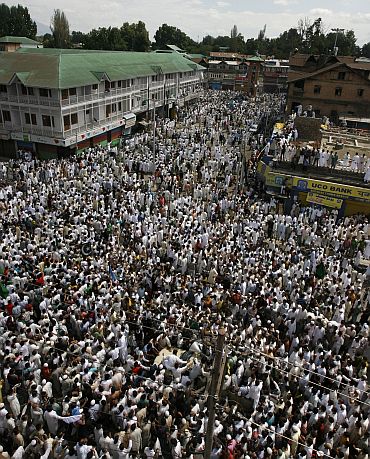Photographs: Danish Ismail/Reuters
The Pandits of the Kashmir valley, currently in exile, the Dogras and Muslims of Jammu, the Buddhists of Ladakh, the Shias and Gujjars in different parts of the state have never been part of any Azaadi movement, let alone any Islamic Azaadi.
They, in fact, are fairly clear that they want greater integration with a secular India, let alone any loosening of ties. In fact, the greater the cry for Azaadi, the greater is the desire for integration in Jammu and Ladakh.
So, what does Azaadi mean for them? It means the continued domination of valley politics and politicians over their affairs. It means the continued neglect of their areas, witnessed during the last 63 years. And, if Azaadi is Islamic, it means further discrimination and insecurity.
Text: Salim Haq/ANI
No government of India can accept the demand for 'Azaadi'
Photographs: Reuters
Finally and perhaps crucially, the demand for Azaadi if understood as freedom from India is clearly unacceptable to the India state. No government of India can accept the demand for Azaadi over the needs of atoot ang. The people of India would never spare such a government, whatever its shape and hue and whatever its majority.
So where does this leave the Azaadi debate?
The example of the 'raiders' in 1947 is clear proof that an Azaad or 'independent' Kashmir would not be able to survive or preserve its independence. Even Gilgit, which overthrew the Maharaja's rule on November 1, 1947 and declared itself independent, could remain so only for less than three weeks before Pakistan took control of the territory.
'Azaadi' cannot be accession to Pakistan
Photographs: Reuters
The colour of Azaadi cannot be green. The minorities would not accept it and it would mean the de-linking of Jammu and Ladakh from the valley.
Similarly, the colour of Azaadi cannot be saffron. The majority would not accept it. Only under the tiranga, a secular India, can the true essence of Kashmir flourish and prosper. It is here that their distinct cultural and ethnic identity would be preserved and strengthened.
Azaadi, too, cannot be accession to Pakistan. Barring a few die-hard votaries, no one in his right mind would think of joining Pakistan. Not only is there distrust of the Punjabi-Pathan elements, there is a realisation that Kashmir's cultural identity would have no chance of survival in a failing and increasingly Talibanised Pakistan.
Azaadi, therefore, has to be freedom from Pakistan, once and for all and freedom to enjoy what the other citizens of India take for granted.
Give the Kashmiris a stake and pride in India
Photographs: Reuters
But, there has to be a limit to what the Kashmiris think they can extract from India in the garb of Azaadi. Bargaining for concessions is a democratic right that all Indians enjoy, no less the Kashmiri. But where bargaining is perceived as blackmailing, and especially if it has an international dimension, then what gets compromised is the freedom to enjoy what others in India enjoy. It also undercuts support that other civil society members and political parties in India can offer.
At the same time, the government of India needs to treat the cry of Azaadi as a cry for justice, a cry to undo past wrongs, and above all, a cry to give the Kashmiris a stake and pride in India, rather than bullets and doles, an assurance that their identity would be as secure in India as is say the Tamil identity or the Marathi identity or the Bengali identity.
Today, clearly, the Kashmiris don't perceive this to be the case. Hence, the cry for Azaadi for want of another slogan that can penetrate the ear plugs worn by the Indian leadership.





article